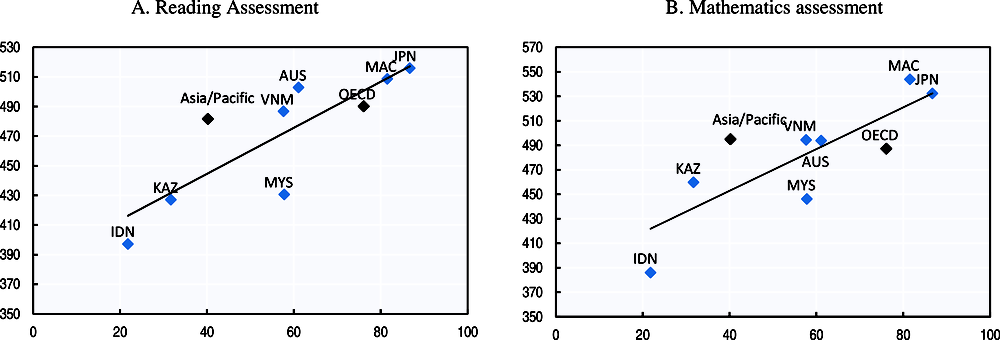Early Childhood Education and Care
Public support for early childhood education and care (ECEC) services helps achieve a range of policy goals. Public investment in ECEC simultaneously enhances child development and helps children acquire the necessary skills to support their future lives, while it also supports parents in their daily quest to balance work and family commitments. As women traditionally engage most in care work, such supports particularly facilitate female labour force participation and are thus crucial to achieving greater gender equality in employment participation.
The extent to which children participate in pre‐primary education (often children age 3-5 inclusive) varies across countries (Figure 4.6). Over the 2007-17 period enrolment rates in pre-primary education in Asia/Pacific economies increased faster than the OECD average, where enrolment rates were already high in the mid-2000s. Pre-primary enrolment ratios tripled in the Kyrgyz Republic, Lao PDR and Samoa, and doubled in Myanmar, Mongolia and Philippines. Gender gaps in ECEC participation are small (Figure 4.7). Girls in Brunei Darussalam, Malaysia, Philippines and Samoa are more likely to receive ECEC services than boys, but boys are more likely to attend ECEC programmes in Macau, China, Nepal and Pakistan.
Results of the OECD Programme for International Student Assessment (PISA) have shown that fifteen-year-old students who had attended pre-primary education perform better on PISA tests than those who did not, even after accounting for their socio-economic backgrounds (OECD, 2011). For the few countries in the region for which data is available, higher rates of ECEC participation in 2005 are associated with higher score of the 2015 OECD PISA reading and mathematics assessment (Figure 4.8).
UNESCO data, net enrolment rate for pre-primary, are used for the early childhood education and care (ECEC) participation indicator. Net enrolment rate means total number of students in the theoretical age group for a given level of education enrolled in that level, expressed as a percentage of the total population in that age group. Therefore, the age of pupils participated in ECEC might differ across countries as targets and times of pre-primary education are not necessary same.
The Programme for International Student Assessment (PISA) is a triennial international survey which aims to evaluate education systems worldwide by testing the skills and knowledge of 15-year-old students. The data was taken from the OECD PISA 2015 Database.
The employment rate is defined as the ratio of employed people over age 15 to the population over age 15. Data was taken from the International Labour Organisation’s Key Indicators of the Labour Market (LILM) Database for non-OECD countries and the OECD Employment Database for the Four OECD countries.
Further reading
OECD (2011), “Does participation in pre-primary education translate into better learning outcomes at school?”, PISA in Focus, 1, OECD Programme for International Student Assessment, www.oecd-ilibrary.org/education/does-participation-in-pre-primary-education-translate-into-better-learning-outcomes-at-school_5k9h362tpvxp-en.



